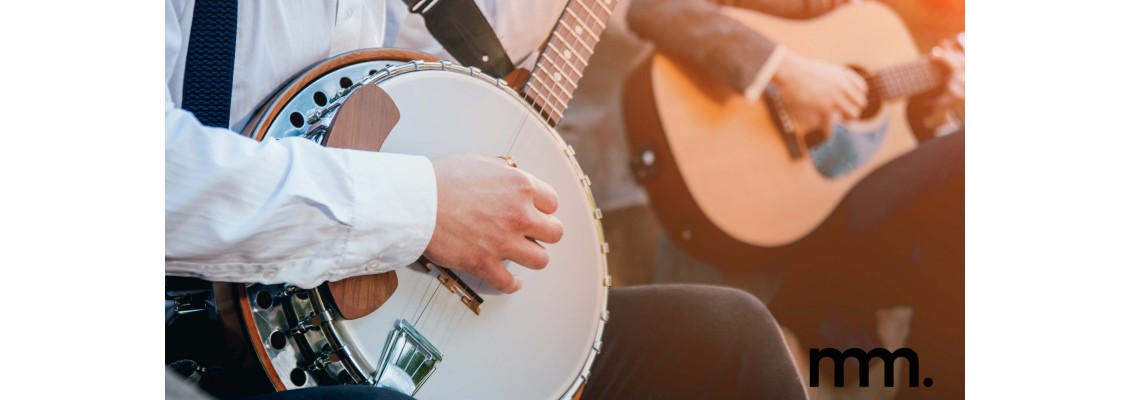
Get Your Pluck On!

This is the staff canteen in Musicmaker.....we live on banjo......
Ah, the banjo. It’s an instrument that evokes the twang of Appalachian hillsides, the snap of riverboat decks, and the lively chatter of a bygone era. It’s as if the banjo carries in its five or four strings the very spirit of joy, wit, and resilience – qualities so fondly celebrated by none other than Mark Twain himself. In fact, if Twain had written a symphony, you might have found it punctuated by the plucky brilliance of a banjo string.
But where does this wondrous contraption hail from, you ask? Well, settle in, friend, for the banjo’s story is one of migration, transformation, and cultural interplay. Its roots trace back over 300 years to West Africa, where similar gourd-bodied instruments with skin-covered tops were central to music and storytelling traditions. These instruments, often strung with gut or plant fibre, were used in communal celebrations, spiritual practices, and oral history.
Enslaved Africans carried these musical traditions across the Atlantic to the Americas during the 17th and 18th centuries. In their new and tragic circumstances, the instrument became both a cultural touchstone and a source of solace. Over time, European settlers began adopting and modifying these designs, introducing wooden rims, additional strings, and mechanical tuning pegs, gradually shaping what we now recognise as the modern banjo.

A lino print by noted historian J. Flems Rathsburger.
By the mid-19th century, the banjo was a staple of minstrel shows, where it gained widespread popularity. Its image as both a folk instrument and a symbol of America’s frontier spirit began to take root. Later, as it was embraced by jazz bands and bluegrass pioneers, the banjo’s versatility and exuberance ensured its enduring place in the annals of music history.
And then, there’s its special role in Irish traditional music. The tenor banjo, with its shorter neck and four strings, has become a beloved staple of Irish sessions. First appearing in the early 20th century, it was adopted by Irish musicians for its bright, cutting tone that could hold its own alongside fiddles, flutes, and accordions. The banjo quickly became a cornerstone for lively jigs, reels, and hornpipes, offering a rhythmic backbone and melodic flourishes. Its distinctive tuning, often in GDAE (the same as the violin), allows it to seamlessly integrate with the traditional Irish repertoire while offering its own unique voice.
The beauty of the banjo lies not just in its history, but in its versatility. It’s an instrument as at home with a mournful ballad as it is with a rollicking jig. Perhaps it’s this dual nature – joyous yet wistful, playful yet profound – that makes the banjo so universally endearing.

The fabled Floating Banjo of Inishcree.
Gold Tone AC-4: A 4-String Banjo That Packs a Punch
Now, let’s turn our attention to a modern marvel that keeps this storied tradition alive: the Gold Tone AC-4 Acoustic Composite 4-String Banjo. This beauty takes a classic concept and imbues it with the best of modern ingenuity. Light as a feather, thanks to its composite construction, the AC-4 is a dream for beginners or seasoned players seeking portability without sacrificing tone.
The 4-string configuration lends itself beautifully to jazz, Irish folk, or even Dixieland. Its resonator-backed design ensures the sound carries with clarity and warmth, making it perfect for sessions, performances, or impromptu riverside jams. And here’s the kicker: it’s available right now at Musicmaker in Dublin. Whether you’re strumming through Stephen Foster classics or carving out your own melodies, the AC-4 promises a musical experience steeped in both tradition and innovation.

Gold Tone AC-1: An Open-Backed Wonder
For those yearning for the unmistakable charm of the 5-string banjo, allow me to introduce the Gold Tone AC-1 Open Back Banjo, complete with its own carrying bag. This instrument is a love letter to the old-time sound – bright, crisp, and delightfully responsive.
Crafted with the same lightweight composite material as its 4-string cousin, the AC-1 is easy on the shoulder yet heavy on tone. Its open-back design gives it that quintessential old-timey resonance, ideal for clawhammer and frailing styles. But don’t let its simplicity fool you: this is a banjo built to withstand the rigours of modern life, whether you’re a street performer, a session musician, or simply a living-room picker.
At Musicmaker, you’ll find this gem waiting to inspire your next musical adventure. And with its included bag, you can rest assured that your AC-1 will travel safely, from Dublin’s cobblestones to wherever the music takes you.

Embrace the Banjo’s Wit and Wisdom
Mark Twain once said, “Against the assault of laughter, nothing can stand.” If ever there was an instrument capable of delivering such an assault, it’s the banjo. Its notes ring out like a chuckle, a story, a reminder that life is as much about levity as it is about meaning.
So why not let a banjo into your life? Visit Musicmaker in Dublin to explore the Gold Tone AC-4 and AC-1, each a testament to the enduring legacy of this remarkable instrument. Who knows – you may find that in plucking its strings, you’re plucking a few heartstrings of your own.
As Twain might say, the banjo is not just an instrument; it’s a companion, a co-conspirator in the delightful mischief of making music. And in that, it’s as timeless as a good story.
Got any questions about banjos? About other Jo's? About the banshee?
Get in touch via the Intercom button below, we are always happy to help out.

Completely real image of our expanded banjo section.




